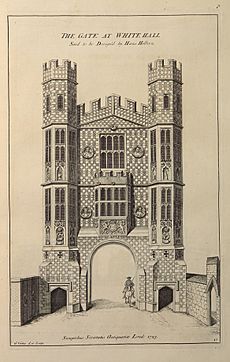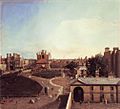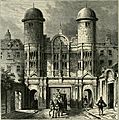Holbein Gate facts for kids
The Holbein Gate was a grand gateway built in London during the time of Henry VIII. It stood across a famous street called Whitehall in Westminster. Built between 1531 and 1532, it was made in a style known as English Gothic.
King Henry VIII had the Holbein Gate built to connect different parts of his huge Palace of Whitehall. This palace was split by the road. The Holbein Gate was so strong that it survived a massive fire in 1698. Many people thought it was the most beautiful gate in Whitehall. Sadly, it was taken down in 1759.
Contents
What's in a Name?
The gate got its name, Holbein Gate, because people used to think the famous artist Hans Holbein the Younger designed it. However, it's very unlikely he had anything to do with its design.
It was also known by other names, like the King's Gate or the Cockpit Gate. This was because it was very close to the Royal Cockpit, a place where people watched cockfights. There was another gate nearby called the Westminster Gate, which was simpler and built in a different style. That gate was taken down earlier, in 1723.
We know what the Holbein Gate looked like from old drawings and engravings. One famous picture was made by George Vertue in 1725.
How the Gate Looked
The Holbein Gate was a rectangular building with three floors. It had large, square bases at each corner. These bases supported tall, eight-sided towers and turrets.
A wide passageway, about 12 feet (3.7 meters) across, went through the middle of the gate. This allowed people and traffic to pass underneath a flat archway. There was also a path for people walking on one side, and possibly another on the other side.
Above the main arch, there was a beautiful oriel window on the first floor. This window stuck out from the building. It had many glass panes, making it very bright inside. The top of the towers had a decorative wall with battlements, like a castle.
Both sides of the gate were decorated with a checkerboard pattern made of flint and stone. There were also fancy carved panels. These included the royal coat of arms, which is a special symbol for the king or queen. You could also see mythical creatures called gryphons holding shields, and other royal symbols like the portcullis (a strong gate), the fleur-de-lys (a lily symbol), and the Tudor rose.
Round carvings on either side of the big windows might have been busts (sculptures of heads and shoulders) made by an artist named Giovanni da Maiano.
Who Lived or Worked There?
The top floor of the Holbein Gate was used as the Paper Office from about 1672 until 1756. This was likely a place where important government papers were kept.
The lower floors of the gate were used as homes. Many different people lived there over the years. For example, the Duke of Lennox lived there around 1620. Later, General Lambert and Viscount Fauconberg were residents.
One very famous person who lived there was Lady Castlemaine, from about 1664 to 1670. Her daughter, the Countess of Sussex, lived there after her.
Why the Gate Was Demolished
Just like another famous gate in London called Temple Bar, the Holbein Gate made it hard for traffic to move along the road. It was a big obstacle for carriages and people.
People started suggesting that the gate should be taken down in the early 1700s. However, some important people, like John Vanbrugh, argued against it, and they managed to save it for a while. Even when the simpler King Street Gate was demolished in 1723, the Holbein Gate stayed. To help with traffic, the archway was made taller so that more vehicles could pass underneath.
However, in 1759, the decision was finally made. The gate and a nearby house were bought and then taken down in August of that year. There were ideas to rebuild the gate in Windsor Great Park, but it seems the materials were just used to fix other buildings instead.
Gallery
-
Whitehall, looking south in 1740. On the left is the Inigo Jones' Banqueting House. The Holbein Gate is in the middle.
-
Whitehall Showing Holbein's Gate and Banqueting Hall by Thomas Sandby, around 1760. This view is from the south.
Images for kids







